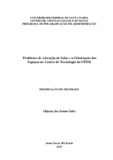| dc.creator | Sales, Elijeane dos Santos | |
| dc.date.accessioned | 2017-04-11 | |
| dc.date.available | 2017-04-11 | |
| dc.date.issued | 2015-03-26 | |
| dc.identifier.citation | SALES, Elijeane dos Santos. Classroom assignment problem and the optimization of the spaces at the Tecnonlogy Center of UFSM. 2015. 120 f. Dissertação (Mestrado em Administração) - Universidade Federal de Santa Maria, Santa Maria, 2015. | por |
| dc.identifier.uri | http://repositorio.ufsm.br/handle/1/4751 | |
| dc.description.abstract | Every beginning of semester higher education institutions face the same dilemma: to assignment courses to classrooms keeping up certain restrictions. This problem is known as Classroom Assignment Problem or Rooms Allocation Problem and consists of allocating courses, with schedules established, at classrooms considering the room capacity and the needs of teachers and students. This process usually is solved manually by the institutions, which can take several days to complete, besides it is hard work and often does not guarantee the efficient allocation of spaces. This reality is also faced by the Technology Center of the Federal University of Santa Maria that due to increasing demand and expansion of the institution needs to adapt to efficiently allocate the available spaces. Currently, the center has 14 undergraduate courses divided into three buildings that have 47 rooms, effectively used, with capacities ranging between 25 and 50 students. Thereby, the aim of this study is to propose a new configuration for the allocation of classrooms in the Technology Center at the Federal University of Santa Maria in order to make the most efficient use of space. Therefore, the study has the support of the precepts of operational research so that a mathematical model was developed to represent the problem. Were used as reference the courses offered in the first and second half of 2014 and from these databases built were coded in ZIMPL and implemented with CPLEX. Because of the problem size, it was decided to split the databases on weekdays and shifts (morning and afternoon) totaling 20 instances. Overall, the results meets the proposed objectives to optimize the spaces and also demonstrated some nonconformities as between the number of vacancies offered by the disciplines and capabilities of rooms. In addition, it was found that there is some imbalance in the supply of disciplines as the days and timeslots, which consequently leads to difficulties for classrooms assignment. Furthermore, it is suggested that further studies are conducted, especially with the use of metaheuristics in order to test the quality of these solutions. | eng |
| dc.description.sponsorship | Coordenação de Aperfeiçoamento de Pessoal de Nível Superior | |
| dc.format | application/pdf | por |
| dc.language | por | por |
| dc.publisher | Universidade Federal de Santa Maria | por |
| dc.rights | Acesso Aberto | por |
| dc.subject | Problema de alocação de salas | por |
| dc.subject | Otimização combinatória | por |
| dc.subject | Pesquisa operacional | por |
| dc.subject | Instituição universitária | por |
| dc.subject | Classroom assignment problem | eng |
| dc.subject | Combinatorial optimization | eng |
| dc.subject | Operational research | eng |
| dc.subject | Higher education institution | eng |
| dc.title | Problema de alocação de salas e a otimização dos espaços no Centro de Tecnologia da UFSM | por |
| dc.title.alternative | Classroom assignment problem and the optimization of the spaces at the Tecnonlogy Center of UFSM | eng |
| dc.type | Dissertação | por |
| dc.description.resumo | Todo início de semestre letivo as instituições de ensino superior enfrentam o mesmo dilema: o de alocar disciplinas às salas de aula respeitando determinadas restrições. Esse problema é conhecido como Classroom Assignment Problem ou Problema de Alocação de Salas (PAS) e consiste na alocação de disciplinas, com horários já estabelecidos, a salas de aulas considerando-se a capacidade da sala e as necessidades dos docentes e discentes. Esse processo, geralmente, é resolvido pelas instituições de ensino manualmente o que além de levar vários dias para ser concluído muitas vezes não garante a alocação eficiente dos espaços. Tal situação também é a enfrentada pelo Centro de Tecnologia da Universidade Federal de Santa Maria (UFSM) que devido à crescente demanda e expansão da Instituição precisa se adaptar para alocar eficientemente os espaços disponíveis. Atualmente, o Centro conta com 14 cursos de graduação alocados em três prédios que dispõem de 47 salas, efetivamente utilizadas, com capacidades que variam entre 25 e 50 alunos. Sendo assim, este estudo se propôs a desenvolver uma nova configuração para a alocação de salas de aula do Centro de Tecnologia da UFSM a fim de tornar mais eficiente o uso dos espaços. Para tanto o trabalho teve como aporte metodológico os preceitos da pesquisa operacional de modo que foi desenvolvido um modelo matemático para representar o problema. Foram utilizados como referência os dados das disciplinas ofertadas no primeiro e segundo semestre de 2014. De modo geral, os resultados encontrados foram ao encontro dos objetivos propostos de otimizar os espaços e também demostraram algumas inconformidades como entre o número de vagas ofertadas pelas disciplinas e as capacidades das salas. Ademais, sugere-se que novos estudos sejam realizados, em especial com o uso de metaheurísticas, a fim de testar a qualidade das soluções apresentadas. | por |
| dc.contributor.advisor1 | Müller, Felipe Martins | |
| dc.contributor.advisor1Lattes | http://lattes.cnpq.br/5941686828835081 | por |
| dc.contributor.referee1 | Garcia, Vinícius Jacques | |
| dc.contributor.referee1Lattes | http://lattes.cnpq.br/5496717370740068 | por |
| dc.contributor.referee2 | Simoneto, Eugênio de Oliveira | |
| dc.creator.Lattes | http://lattes.cnpq.br/2127188008918517 | por |
| dc.publisher.country | BR | por |
| dc.publisher.department | Administração | por |
| dc.publisher.initials | UFSM | por |
| dc.publisher.program | Programa de Pós-Graduação em Administração | por |
| dc.subject.cnpq | CNPQ::CIENCIAS SOCIAIS APLICADAS::ADMINISTRACAO | por |


